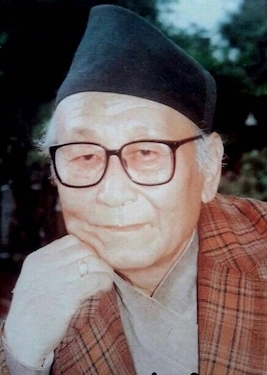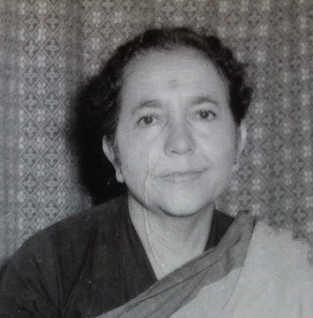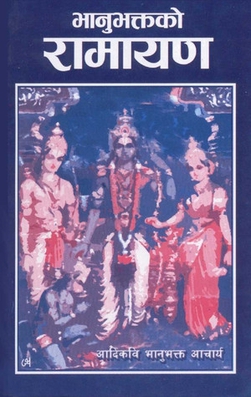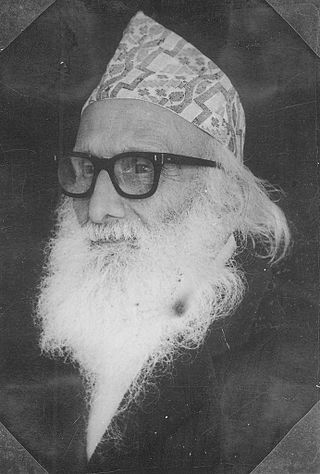
Bhanubhakta Acharya was a Nepali writer, poet, and translator. He is widely regarded as the oldest poet in the Nepali language, for which he was conferred with the title of "Aadikabi": literally, "the first poet".

Nepali literature refers to literature written in the Nepali language. The Nepali language has been the national language of Nepal since 1958.
Nepali literature is the literature of Nepal. This is distinct from Nepali literature, which is the literature in only Nepali language. The major literary languages of Nepal are:
PanditKavirajNara Nath Acharya (1906–1988) was a Nepalese Pandit, Kaviraj and writer in Sanskrit and Nepali. He is best known for his biography of his great uncle, the poet Bhanubhakta Acharya, first published in 1960.

Motiram Bhatta was a Nepalese poet, singer, essayist, publisher, literary critic and biographer. He is considered the first biographer and literary critic of Nepali literature and is credited for starting the first private printing press in Nepal in c. 1888. He also introduced the Ghazal style of poetry and singing in Nepal. Bhatta was a polyglot and alongside Nepali, he had studied in Sanskrit, Persian, English and was also proficient in Bengali, Urdu and Nepal Bhasa.
Ganga Prasad Pradhan was born on July 4, 1851, in Kathmandu and was the first ordained Nepali Christian pastor, main translator of the Nepali Bible, co-author of an English-Nepali dictionary and author of children's textbooks.
Jagadamba Shree Puraskar is an award given to a person or an organization for contribution to Nepali language, literature, art and folk culture.

Shiva Kumar Rai (1919-1995) was a Nepali language writer and politician from Darjeeling, India. He won the Sahitya Akademi Award in 1978 for his collection of short stories Khaharey. He was the first Gorkha minister in the state of West Bengal after becoming a deputy minister in 1952.
Kumar Pradhan was an Indian historian and writer whose research interests include the History of the Eastern Himalayas, Genealogical studies and the Nepali literature. Pradhan has also edited and written a number of literary journals and anthologies and published learned articles in Nepali. He was the chief editor of Sunchari Samachar and other prominent Nepali newspapers.

Nepali is an Indo-Aryan language native to the Himalayas region of South Asia. It is the official, and most widely spoken, language of Nepal, where it also serves as a lingua franca. Nepali has official status in the Indian state of Sikkim and in the Gorkhaland Territorial Administration of West Bengal. It is spoken by about a quarter of Bhutan's population. Nepali also has a significant number of speakers in the states of Arunachal Pradesh, Assam, Himachal Pradesh, Manipur, Meghalaya, Mizoram and Uttarakhand. In Myanmar it is spoken by the Burmese Gurkhas. The Nepali diaspora in the Middle East, Brunei, Australia and worldwide also use the language. Nepali is spoken by approximately 19 million native speakers and another 14 million as a second language.

Chakrapani Chalise was a Nepalese poet. He wrote the words of the first national anthem of Nepal in 1924 AD to the music composed by Bakhat Bahadur Budhapirthi in 1899 AD. The musical part of anthem was created during Prime Minister Bir Shamsher Jang Bahadur Rana's era. Later the Nepali Language Publications Committee was ordered to write words for the anthem. Chakrapani being assistant to Superintendent of the Committee, wrote the words for the anthem.

Dev Kumari Thapa was an Indian Nepali-language writer, who mainly wrote stories.

Bhanubhakta Ramayana, commonly known as Ramayan, is the Nepali translation of Valmiki Ramayana by Adikavi Bhanubhakta Acharya. It was posthumously published in its complete form in 1887. It is widely considered to be the first Nepali epic. The prose style of the epic has been termed Bhanubhaktiya Laya since it was completely original in Nepali literature, being the first work. Due to this distinction, the author, poet Bhanubhakta Acharya is known as Adikavi in Nepal.

Dharanidhar Koirala was a Nepali poet sometimes known as Pandit-ji.

Surya Bikram Gyawali was a Nepali historian. He wrote biographies for numerous people including King Prithvi Narayan Shah and writer Bhanubhakta Acharya. Gyawali also served as a head teacher in Darjeeling. He is also a recipient of the Order of Gorkha Dakshina Bahu, the Order of Tri Shakti Patta, and the Tribhuvan Puraskar (1971).
Hridaya Chandra Singh Pradhan was a poet, writer and social worker of Nepal. He wrote against the ill customs and corruptions against the Rana regime.

Parasmani Pradhan was an Indian Nepali-language writer, poet, translator, grammarian, educator and publisher. He published multiple Nepali language textbooks and played an important role in shaping the modern Nepali grammar. He was one of the key figures who contributed in establishing Nepali as one of the official language of India.

Bir Charitra is a Nepali fantasy novel written by Girish Ballabh Joshi. The first part of the novel was written in c. 1899 and was published in 1903 by Pashupat Press but soon the Rana government restricted the publication of other volumes. The complete all four parts of the novel was published only in 1965 by Jagadamba Press. It is considered to be the first novel of Nepali literature.

Sardar Rudra Raj Pande (1901–1987) was a Nepali educator, writer and historian. He served as the Headmaster of Durbar High School from 1925 to 1938, the Headmaster of Tri-Chandra College from 1938 to 1951 and the Vice Chancellor of Tribhuvan University from 1964 to 1969. He wrote multiple novels including Rupamati, which is considered as one of the earliest novels written in Nepali language. He also played an active role in establishing SLC examination board and Department of Archaeology.

Moon Poudel is a writer of Nepali literature. He is best known for writing satire and ghazals in Nepali language. He was honored with the Bhairab Puraskar in 2080 BS by the Bhairab Puraskar Guthi for his remarkable five decades of contributions to Nepali satirical essays.













